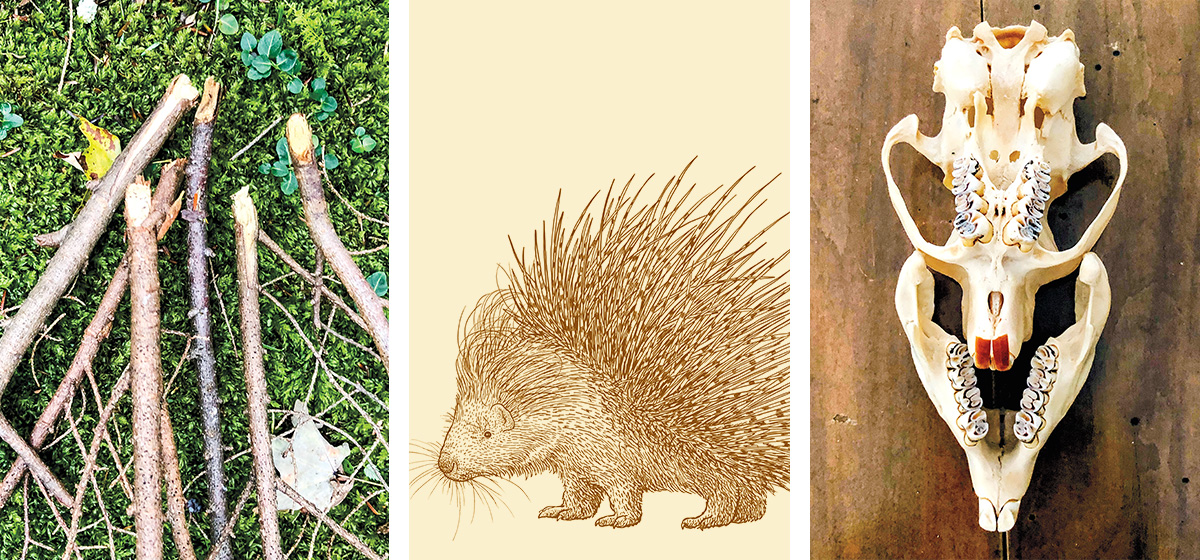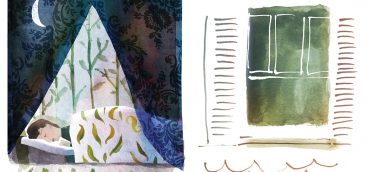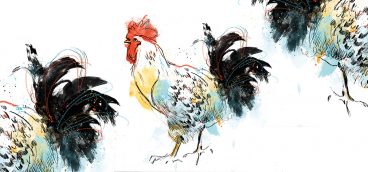Mysteries of the Porcupine

This is how a porcupine attacks. It turns its back, displays the black line running down the middle of its tail, edged with white quills visible in the dark.
Its body shivers.
The jaw clenches, incisors vibrate, and the teeth clatter.
It emits an odor.
Quills become erect.
These are mere warnings.
If not enough to deter a predator, only then does the porcupine let loose its greatest defense: up to 30,000 quills, 1½–4 inches in length.
A quick flick of the tail can send quills into its victim. But the quills are not projectiles.
“It is probably this split-second tail slap that has given rise to the persistent but false rumor that porcupines throw their quills,” Uldis Roze writes in “The North American Porcupine.”
I have never seen a porcupine. How do I know, then, that porcupines live in our woods?
That they sleep by day in trees, rocky dens, or one of our outbuildings, leaving at dusk, walking the earth only at night? Because I’ve seen porcupine quills embedded in the muzzles of a giant schnauzer and a golden retriever, confirmed with a nighttime visit to a vet, where he, my husband, our daughter and I removed 300 quills from two sedated dogs.
The dogs stuck their snouts where they weren’t welcome, presumably smack into the porcupine’s neck, where barbed quills protect its upper body.
“The predator’s own momentum embeds the quills,” Roze writes.
I know because, for the first time in 31 years on this farm, I saw in last winter’s dullness the base and snake-like roots of an elm gnawed by a porcupine in a triangular pattern that shone a vibrant cinnamon against an otherwise grey landscape.
“The pattern of tooth scrapes left on the bark by an adult porcupine displays the animal’s craftsmanship,” Roze writes. Like beavers, porcupines use orange incisors to chew down to the cambium, but Roze describes the porcupine’s gnawing as more finely finished than the beaver, the bark removed in “five or six scrapes converging on an apex, like sticks in a tepee.”
John Wenzel, director of Powdermill Nature Reserve, has seen porcupines. “This is a huge year for them,” he said. “I don’t know why.” Usually he sees a porcupine once every two years, but this year he’d seen five by August, and others have reported seeing porcupine roadkill. “Obviously the porcupine population is growing.”
Wenzel showed me what he described as “terrible (wonderful) damage” that has killed big trees on Powdermill’s Porcupine Ridge trail. At 1,700 feet, the trail was named for three tulip poplars girdled by porcupines. The 50-year-old trees remain standing for visitors to see (unlike beavers, porcupines do not fell trees) but none will survive long. When I told Wenzel I wanted to see “niptwigs,” little did I know what a journey he’d take me on, a harrowing ride in an all-terrain vehicle deeper into Powdermill’s woods, on rocky trails, through thick brush, up and down river banks, and over fallen trees.
Niptwigs he showed me: the remains of twigs chewed at an angle, tossed by porcupines from atop a hemlock. Porcupines eat small twigs and needles of the hemlock, but not the bark because of the high tannin content. Piles of niptwigs rested on the forest floor.
I’ve not seen porcupines shimmy up and down trees, aided as they are by textured footpads, tail bristles that prevent backsliding, and curved claws for grabbing. Nor have I seen them fall out of trees, which they do fairly often, reaching a tad too far for a tasty morsel. About one-third of porcupine skeletons reveal multiple broken bones, some of which don’t heal properly and prevent them from climbing—hence nibbling a tree’s base instead of the preferred crown. Weighing 12–35 pounds, the North American porcupine (Erethizon dorsatum) is the largest of the world’s porcupines (and North America’s second largest rodent after the beaver), but they lack the advantage of their South American cousins: a prehensile tail. And while weight helps them survive the cold, it can result in mighty hard falls. Sometimes they even impale themselves on their own quills.
Tumbles notwithstanding, porcupines generally live 5–7 years—although Roze followed one that lived until 21—and measure about 18 inches in length, with an additional 8 inches for the tail. Porcupines head into dens in November but do not hibernate. They lose 40 percent of their weight during winter.
Those who see porcupines up close can’t help but notice the parasites that live on the animal. “Hands down they are the most heavily parasitized mammal in North America,” said Stephen Rogers, collection manager of Section of Birds at Pittsburgh’s Carnegie Museum of Natural History, who wrote his master’s thesis on porcupines. Porcupines have tape and round worms, ticks, fleas, lice, and occasionally scabies, a mite that burrows into skin, makes the hair fall out, and can cause death.
Porcupines are herbivores, eating a diet of leaves, fruit, buds, nuts and bark, none of which supplies adequate salt, so the animal voraciously seeks the mineral. “They’ll eat ax handles,” Rogers said. “I have seen them chew on natural gas pumping stations out in the woods of northern Pennsylvania and aluminum signs because the aluminum corrodes, forming a salt.” Porcupines munch on plants covered in road salt and particularly like plywood, bringing them too close to cars and people, which can be lethal.
Mating, which occurs in the fall, is not as spiky as one might imagine. The female curls her tail upwards to move quills out of the way; the male places his forepaws under her quill-free tail. The seven-month gestation is “one of longest known in the animal world,” Roze writes. Single, one-pound babies are born, with fur and quills inside an amniotic sac. The quills are soft until the mother licks off the sac; then they harden within an hour.
I so enjoyed Uldis Roze’s book that I called to ask if he’d speak to me. Professor emeritus from Queens College at CUNY, Roze is perhaps the world’s preeminent expert on porcupines. He was as gracious as his book was fascinating. We spoke first of the fisher, the porcupine’s fiercest natural predator, which repeatedly attacks the porcupine’s quill-free face until it becomes disoriented and cannot turn backward. “Fishers are an efficient hunter of baby porcupines,” he said. Reintroduced in New York State in the 1970s and in Pennsylvania in the 1980s, fishers have reduced porcupine populations by 90 percent or more, Roze told me. “Our population has sunk, bottomed out,” he said from his home in the Catskills. “Porcupines do best where fishers are least.”
He kindly answered a slew of my questions.
Baby porcupines aren’t really called porcupettes?
They are.
What is a station tree?
“A rest tree” where they sleep during the day.
And a witch tree?
A tree with a disoriented canopy caused by years of feeding on the upper bark. It can look like a broom or other shapes, but always stands out, looks unnatural, and often has porcupine droppings on the ground below. The porcupine itself is seldom seen in the witch tree because it feeds at night.
What does the porcupine smell like?
Like nothing else in the forest. (His writings include the words invasive, powerful, pungent and repellent.) “One’s eyes begin to water and the nose runs.”
Are quills hollow or is that a myth?
Quills are not hollow but have a spongy matrix in the middle, which doesn’t add weight, but adds rigidity. They have surface fatty acids that kill bacteria and act as an antibiotic. If you get a wood splinter, it can swell and become infected; a porcupine quill won’t do that.
Some have referred to the porcupine as unkempt.
The quills are straight and clean. A relaxed porcupine looks as neatly combed as a model for hair lotion.
Should quills be cut to remove them?
No. Pull them out. Since they are barbed like fish hooks, be careful not to lose your grip or the tip can travel deeper into the skin.
Do males urinate on females before mating?
They do, but in drops, not a stream. It’s not a water sport, but brings the female into estrus.
Do females really spend nearly their entire lives pregnant?
7 months pregnant, 4 nursing, and 1 for mating. Repeat.
Have porcupines been affected by climate change?
They may have benefitted because the species has expanded north into the Aleutian peninsula of Alaska where they were absent previously.
How did niptwigs get its name?
Niptwig is a word I made up and it is now accepted by Scrabble.
How might I find a porcupine?
Fall and winter are the best seasons to see porcupines. Summer, forget it. You’ll never see a porcupine in a tree with leaves on it. Look up into leafless tree canopies for a black mass against the sky. Follow tracks in the snow to dens, such as rock outcroppings or crevices with urine at the entrance. Take a flashlight and look inside.
Roze is a man who has seen porcupines, tracked them, studied them, held them. But for me, the porcupine remains elusive. I was reticent at first writing about an animal I had not seen, but then so much of the natural world is just beyond our sight, creating a kind of blind faith that allows our imaginations to take over. And isn’t that part of the wonder of it all: the nighttime sound of the Great Horned Owl; the smell of a skunk; cracked walnut shells lined up on a stone wall by a chipmunk or squirrel; the cicada exoskeletons I turn so delicately in my hand. We may not see such creatures, but we know they are here, living among us.
And what a joy to search for the porcupine, to look up into leafless trees. Examine potential dens. Forage for niptwigs under our farm’s hemlocks. Keep my eye out for witch trees, and try to identify unusual scents. I know now to listen for cries between competing males, and in winter, I will hunt for the porcupine’s distinctive tracks in the snow, wide tails sweeping behind.





